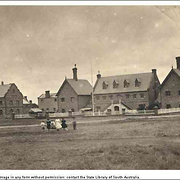
Destitute Asylum and Police Barracks, c. 1868, by B. Goode & Co., courtesy of State Library of South Australia.
Details
The Destitute Asylum was established in Adelaide by the Destitute Board in 1851. It provided accommodation for the destitute, including children and a separate lying-in Home for pregnant girls. Following the passage of the Destitute Persons Relief Act 1866, children living at the Destitute Asylum were removed to the Exhibition Building, North Terrace in 1866 and then in early 1867 to the Grace Darling Hotel in Brighton and Church-run institutions. When the Magill Industrial School opened in 1869, children in these temporary homes were transferred there. Some girls remained at the Asylum until 1881 when they were moved to the Girls' Reformatory, Magill. The Destitute Asylum ceased to be an institution for children in 1881. The Destitute Asylum continued until 1917, and the Lying-in Home operated until 1919.
In 1849, with the setting up of the new Destitute Board, the government took on more responsibility for the care of poor and neglected colonists. Initially a number of temporary shelters were established in Emigration Square in the west parklands of Adelaide. However the temporary huts were soon found to be inadequate and in 1851 the government granted the Destitute Board access to part of the barracks complex on Kintore Avenue, next to Government House. The first residents moved into their new quarters on 10th May 1851.
The Destitute Asylum was the first institution of its kind in Australia. Its role was to provide supervised 'indoor relief', meaning shelter and food, for the destitute poor. This included men, women and children, pregnant women, the elderly, people with intellectual and/or physical disabilities, people with alcohol problems or who were suffering from chronic illnesses such as leprosy. Aboriginal people were also eligible for sheltered relief at the Asylum but were housed separately from other residents.
In the mid 1850s a number of buildings of various types were erected on the grounds of the Destitute Asylum to accommodate increasing numbers. By 1856 the Asylum was providing shelter for 65 women, 30 men and 43 children. Living conditions in the Asylum were basic and crowded and the institution was often criticised in the press for being unclean and unhealthy.
In the mid 1850s the children accommodated in the Asylum attended a free school. However, as numbers of children increased, so did concern about whether the Asylum, with its aged, ill and sometimes disturbed inmates, was the right place for them. The Destitute Persons Relief Act 1866- 67 introduced two new ways of dealing with children charged as being neglected. They could either be 'boarded out'- meaning sent into foster care and/or service with families who were regarded as respectable - or they could be moved into the yet to be built Industrial School, an institution specifically designated for children.
As a result of the passing of the Act, the vast majority of the children in the overcrowded Destitute Asylum had to be moved out. Unfortunately, no permanent Industrial School yet existed. In addition, the military barracks section of the Asylum where the children were housed needed to be vacated in order for the British Army to reoccupy the barracks. The arrival of the XIVth Regiment made the removal of the children from the Destitute Asylum urgent so the government had to make temporary arrangements.
In November 1866, a group of approximately 60 children from the Asylum were sent to makeshift accommodation in the Exhibition Building on North Terrace. This building was considered extremely unsuitable and in February 1867 the majority of the children were moved to again to a former Hotel in Brighton, the Grace Darling. When the Grace Darling Hotel quickly became overcrowded other children from the Destitute Asylum were sent to the St Vincent de Paul Orphanage, run by the Catholic Church, and the Orphan Home, run by the Church of England. Once the new Magill Industrial School was completed in 1869, 157 children from these temporary homes were sent there.
A separate Lying-in Home for pregnant girls was created at the Destitute Asylum grounds in the mid 1860s. Also girls who had committed an offence or had behavioural problems continued to be accommodated within the buildings that made up the Destitute Asylum until they were moved out to the Girls' Reformatory, Magill in 1881. From that year the Destitute Asylum ceased to be an institution for children. However, the Lying-in Home continued to operate at the site until 1919.

Sources used to compile this entry: 'THE DESTITUTE ESTABLISHMENT.', South Australian Weekly Chronicle (Adelaide), 26 October 1867, p. 4, http://nla.gov.au/nla.news-article91259385; 'Destitute Asylum', in History of Disability in South Australia, Disability Information and Resource Centre, 2007, http://web.archive.org/web/20140307172652/http://history.dircsa.org.au/1800-1899/destitute-asylum/; '19 March 1849 Destitute Asylum', in SA 175, Professional Historians' Association (South Australia), 2011, http://www.sahistorians.org.au/175/chronology/march/19-march-1849-destitute-asylum.shtml; George, Karen, Finding your own way, Nunkuwarrin Yunti of South Australia Inc., 2005, http://nunku.org.au/resources/; Geyer, Mary, Behind the wall: The women of the Destitute Asylum Adelaide, 1852-1918, Wakefield Press, Adelaide, 2008.
Prepared by: Karen George and Gary George
Created: 9 February 2011, Last modified: 29 May 2015